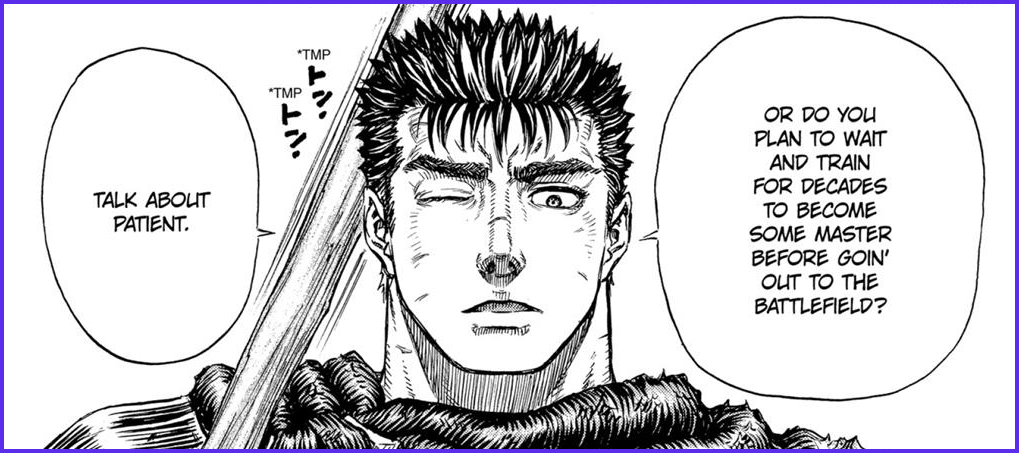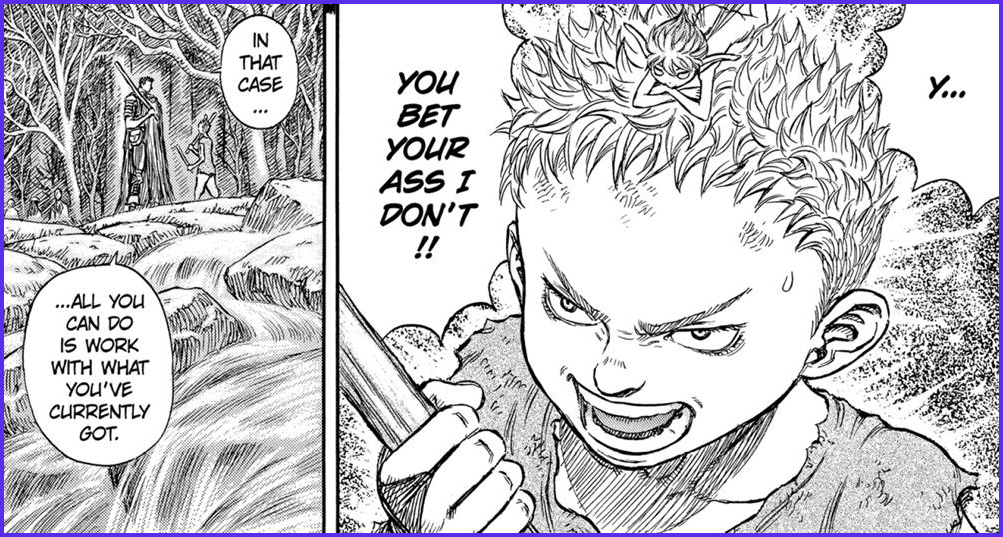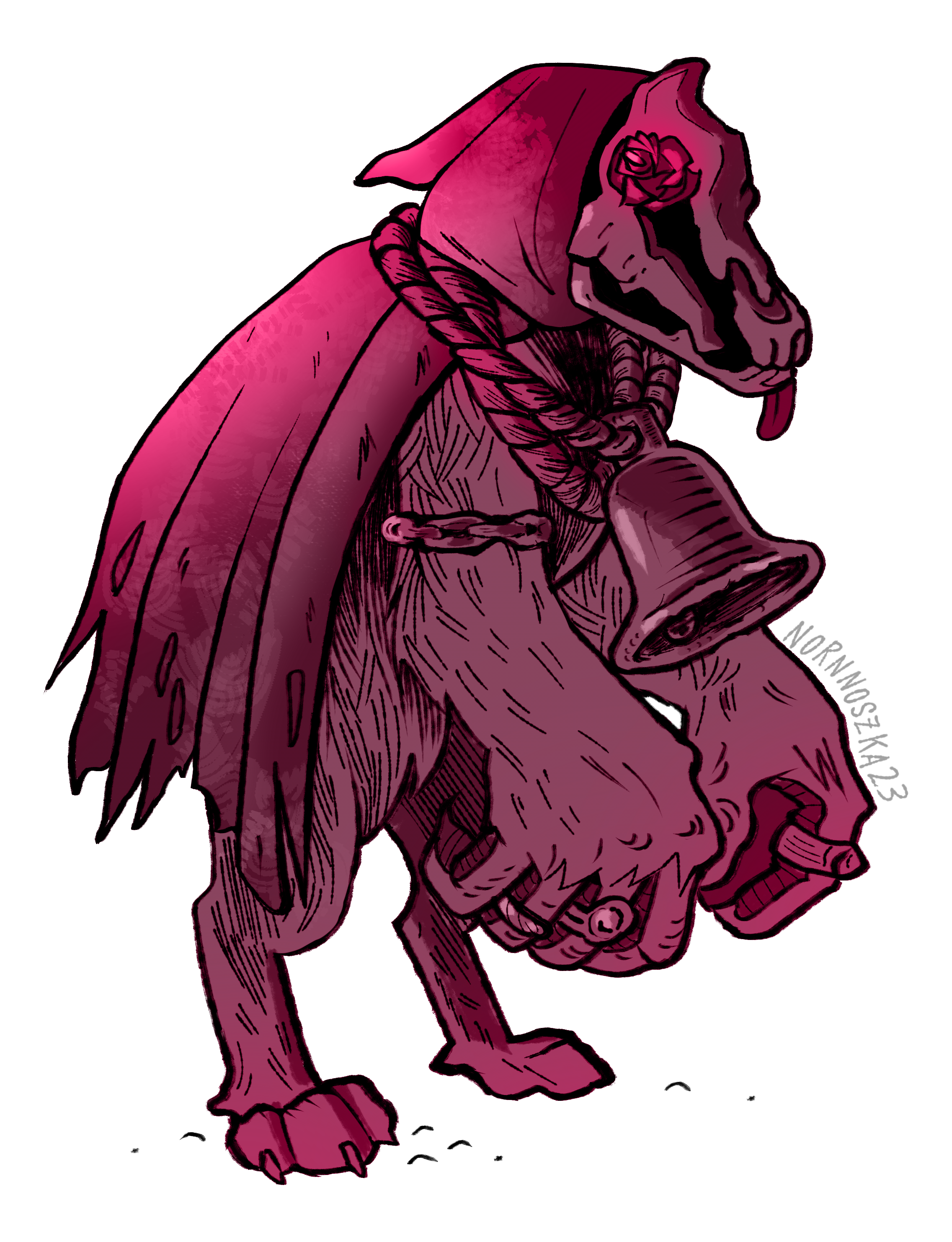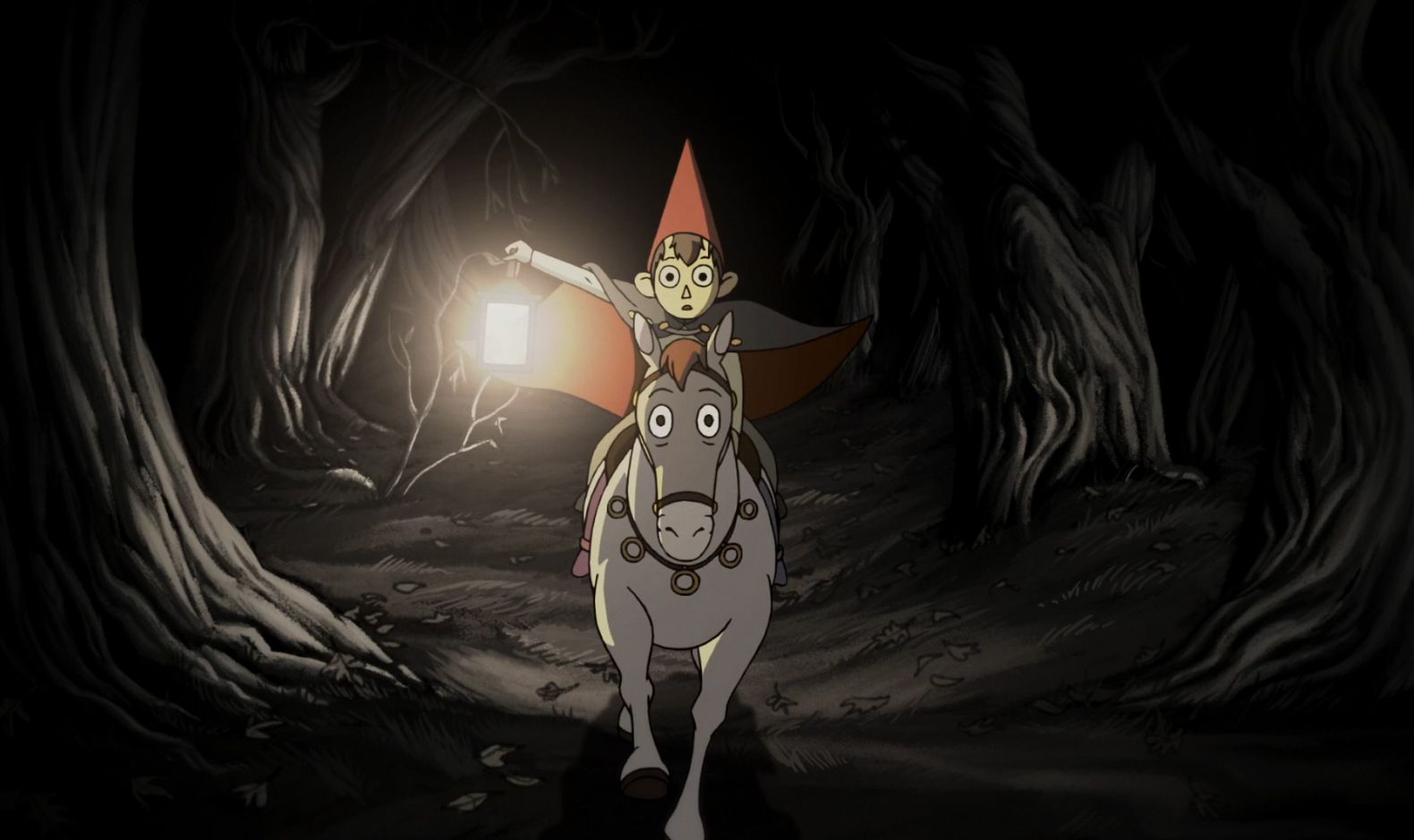Kentaro Miura on Skill
I’m reading Berserk.
There’s a part—almost 200 chapters in—where Guts is teaching Isidro how to fight. Here’s the panels:



The core of these panels seem to be drawing on Kentaro Miura’s musings on the creation of art more than they’re drawing on his knowledge of warfare and sword-fighting. When I first came across them, they struck me immediately as Kentaro’s thoughts in regards to others asking him “how do I become you?” And I think with just these six panels, we get the answer:
You cannot practice your way into becoming a master.
You are not, and never will be, Kentaro Miura.
New Year’s Resolution Systems
Prismatic Wasteland has issued a challenge and who am I to resist such a thing?
My challenge is thus: In January 2024, come up with a new resolution mechanic for a TTRPG and give it a name. It doesn’t need to be good (in fact, most the good ones have probably already been taken). It just needs to be new! You don’t need to plan to use it in your games; it can be absolute detritus for you. But one blogger’s trash is another designer’s treasure. You never know how great an impact one throwaway idea on a blog might have.
2023 Mindstorm Retrospective
Alright, another year in the books means that we’re going to go through files, notes, and memories and try to recap this thing. This is a mostly self-indulgent post, rough around the edges, and posted for posterity’s sake.
A Demon of Three Notes
 The children run through the village, laughing and singing in harmony. The organist in the temple plays music that would rival even the great masters of the world. The dour fisherman, who smiles for nothing and no-one, hums a cheerful tune. Those who never had the ear for music wake up with perfect pitch, the harmonies sinking into them, resonating with the songs in their souls. Instruments are taken up and mastered, flutes and lutes and little harps. The town gathers at night and sings the deep songs, the true songs, the night songs, smiling and laughing as they dance and embrace.
The children run through the village, laughing and singing in harmony. The organist in the temple plays music that would rival even the great masters of the world. The dour fisherman, who smiles for nothing and no-one, hums a cheerful tune. Those who never had the ear for music wake up with perfect pitch, the harmonies sinking into them, resonating with the songs in their souls. Instruments are taken up and mastered, flutes and lutes and little harps. The town gathers at night and sings the deep songs, the true songs, the night songs, smiling and laughing as they dance and embrace.
Beneath it all, deep within the earth, the demon slumbers, growing stronger with each note that passes through joyful lips.
Gulch
Welcome, traveler, to Gulch. This town ain’t much, but it’s ours, and we’d appreciate it if you’d not muck about in our business, thank you very much. You might be tempted to dive under the surface, get to know the people here, and try helping them out. Don’t. That’s just going to piss someone else off, you see? Best to fill up your car and keep on moving on
Under the Hood of the Garden Wall

What can Over the Garden Wall teach us about adventure design? The 10 episodes are tight, full of surprises, and effortlessly entertaining. For the most part, they seem to share a foundational structure that we can pull out of the show and apply to roleplaying games. You can’t plan a “story” in an RPG, but that doesn’t mean you can’t set something up to be fun and engaging for everyone at the table.
Ringing the Bell, A Simple Reputation System
Imagine a character that has been through it all: hard fought victories against deadly foes, slaying monsters of legend, delving into depths unknown, and wielding the old magics of the world in the form of their weapons, gear, or arcane trickery. One of the coolest experiences to have at the table with a character like that is when their reputation proceeds them. When their titles are shouted out in backwater towns, when the lord of the land calls upon them to solve a problem, when their past catches up to them because it’s been hard-won in the crucible of action.
There is nothing quite as striking and commanding as a name on the lips of many.
Ransacking the Room
Usually, the way I handle players exploring a location is pretty standard: I describe the location, point out the interesting bits, and let the players inform me how their characters are checking things out. If there are secret things in the location, I’ll hint at them (either in the main description, or in further descriptions as they search). Basically, nothing revolutionary—I’m using Justin Alexander’s Matryoshka Search Technique.
This works really well in ruins, dungeons, haunted forests, and the other milieu you typically find in an OSR-ish game. I, however, am merely a POSR, and my games don’t contain all that many ruined dungeons for the players to explore. Instead, they often find themselves dealing with dangerous locations in populated areas—and that involves a lot of B&E into the lairs of the bad guys.
Spell FRIEND and Enter
In the following post I’m going to lay out a foundational structure for using scrabble tiles in two different, but connected, ways. The first is using the tiles as a key to unlock the ancient dungeons in the world, where the more tiles you have the more dungeons you can unlock (and gain more tiles from). The second application comes in a Tears of the Kingdom-esque application of creativity, where your characters can use the tiles to magically modify objects in the world to solve the problems they encounter.
This requires two things to be true about the setting.
Question-Based Adventure Design (Q-BAD)
Anyone who knows me knows how much I love spreadsheets, and that’s why—like an absolute freak—I write the first draft of my adventures in a spreadsheet. Hold on. Don’t leave. You don’t have to use a spreadsheet. It’s just easiest for me.
There’s really only one step to that first draft—and I’m using first draft pretty loosely here—instead of something hammered down, ready for editing, my initial pass on an adventure mostly lives inside of my head, with about 10% of it on the spreadsheet, like some kind of RPG iceberg.
Tension Cheatsheet
In the latest POSR game I’ve been running we’ve played eleven sessions and the players have only explored two dungeons—and those dungeons only took five sessions between both to clear to their satisfaction. That means that for this game, we’ve spent six sessions not dungeon crawling.
Lots of stuff has happened. They rooted out the cause of a missing village. They met with the leader of a powerful clan in the last city. He introduced them to his “burn everything, ask questions never” special forces team dedicated to taking out cosmic-monster worshipping clans hidden about. They’ve made friends with a group of travelling merchants called the Nine Thumbs. They’ve went to a dark and spooky theatre and watched a performance about themselves. They’ve made a lot of messes, too. Right now, they’re attending the “wedding of the year” between two clan scions.
The Pirate Crew
I think something that almost every GM seems to go through is the elusive “ship game”, where the characters are all members of a crew of some kind of ship (sailing or space) and they go around doing various odd jobs. My group has tried to run this game numerous times with many systems and we’ve just wrapped up the latest attempt: a mini Scum & Villainy campaign.
Dwiz over at Knight at the Opera has talked about running a pirate game in a great manner of detail and I think it’s a great post. One of the three pillars he talks about are “social challenges” between the crew. I’m going to spend this post trying to flesh this out a bit using ladder tables. You’ll need to be familiar with that post.
Stealth Turns
As I gear up to run another game for my friends, I’ve been fiddling with my own system. I’m trying to mesh together multiple things that I love—characters with cool abilities, an easy resolution system, procedural play, and a science-fantasy mileau.
As such, I’ve been thinking about how best to employ the hazard die and turn-based structure to the game. Ava has mentioned before that she believes the Event Die in Errant is the engine that drives the game, and I wholeheartedly agree. As such, I’ve been thinking about how to leverage the Event Die in a structure that will be less about crawling through dungeons, and more about adventure, exploration, and character-based scenes.
Nested Monster Hit Dice
Like almost everyone, I’ve spent some time thinking about Witcher style monster hunting in RPGs, racking my brain over and over again as I try to “solve the case” as it were. Often the advice suggests vibe and a certain procedure of play:
- Run the monster as a “puzzle” instead of a straight up fight. Do this with resistances, immunities, and weaknesses.
- Make discovering information about the monster the main purpose of the adventure. A successful investigation leads to a fight that is significantly easier as a result.
This is solid advice in terms of trying to evoke Witcher vibes, but it doesn’t really scratch the itch in the right way for me. The other inspiration I’m drawing from is Horizon: Zero Dawn, which has you targeting the components of the beasts you’re hunting as opposed to just smashing the side of them with your spear.
Matrix Campaign Structures, Part 2B
This should be a quicker post than Part 1 and Part 2B, thankfully. I think we’re hitting the stride now and can pick up some speed—I’ve discussed why I’m making these procedures, how I’m making them, and breaking down the concepts that go into them.
To recap, the four “major” procedures that make up the Matrix loop are:
Matrix Campaign Structures, Part 2A
Apologies for the bit of the delay in getting part two out the door. I’ve been swamped lately with editing Barkeep on the Borderlands and the blog is the first thing to suffer. This adventure is going to be amazing, though.
The previous post in this series laid out the groundwork of what we’re trying to do here: build a set of procedures, unconnected to ‘system’, that let us play an RPG campaign that has the vibes and structure of The Matrix movies.
Matrix Campaign Structures, Part 1
If you’re anything like me, you’re a thirty-something year old living in Canada that like fries (my fav food), bouldering (indoors only), reading overhyped fantasy novels (without shame), and listening to your friends talk RPG theory (procedures lately).
If you’re not like me, but you’re reading this blog, you may have seen a few posts going around lately discussing the nature of procedures, structures, and gameplay loops. Here’s a few good links:
Treasure Squares
This post is my own musings and an extension on WD’s excellent post on monster design. Seriously, it’s good stuff. Go read it.
It occurred to me that you could extrapolate the idea into more than just monster design. Really, you could use this sort of thing as a through-line for everything in your world, but that’s an entirely different post. Instead, let’s take a look at a way you can use it to create unique and exciting treasure.
Mindstorm Press First Quarter
The title of this post is nothing more than a fancy way of me saying that I’m going to talk about the last three months. I had originally planned to do monthly check-ins, but I skipped the first two months, so now I’m compiling a first quarter instead.
Let’s start with the thing that really matters: how many games I’ve managed to play in so far this year. The total? 18 sessions worth of gaming, clocking in at 61.5 hours. Nice. One of those was 9 Lives to Valhalla on stream with PlusOneExp and the rest are split between personal groups. Only one of those is a game that I GMed—kind of disappointing here, since I want to run more games, but that’s just how it shakes out sometimes.
Creating A Game Hopping Secret Society
When my friends are having fun, I’m having fun. When I’m running an RPG, one of the main questions sitting at the forefront of my mind is are they having fun? Most of the decisions I make in terms of games (what to run, what to focus on, what to prep) filter their ways through that lens. What’s the most fun my friends can have, and how the heck do I make that happen? That’s a big part of my fun. There’s probably some kind of term for this type of personality. It might not be healthy. I refuse to think too hard about it.
The Mindstorm Weekly, Jan 17–24, 2021
A roundup of the things I was checking out this week.
The Mindstorm Weekly, Jan 10–16, 2021
A roundup of the things I was checking out this week.
The Mindstorm Weekly, Jan 3–9, 2021
A roundup of the things I was checking out this week.
The Mindstorm Weekly, Jan 3–9, 2021
A roundup of the things I was checking out this week.
2021 Retrospective
2021 has been a difficult year. I’ve been “lucky” in that I work a day job that I still need to physically be at and it’s been relatively busy. That means that I haven’t been working from home, and for the most part, my “daily” routine hasn’t actually changed that much.
But the lack of physical activity over the pandemic has certainly affected me.
The Mindstorm Weekly, Dec 20–27, 2021
A roundup of the things I was checking out this week.
Adding Congruency to Anti Canon Worldbuilding
Can a world spontaneously erupt from the minds at the table and follow a ley line of verisimilitude at the same time?

The Mindstorm Weekly, Dec 13–19, 2021
A roundup of the things I was checking out this week.
How To Set A DC in a D20 Dungeon Game
“Alright,” your friend the fighter says. “I’m going to smash down the door.”
Great. You’ve got options. In fact, you might have too many options.
If you’re using a module, there might be a piece of information somewhere that says “the doors are iron, and need a DC 20 check to smash down.” Tell your friend to hold on a sec while you check the book. No problem, not really.
If you’ve made up your own doors—fancy you—you might already know what your friend needs to roll against to get ’em down. Great.
If (and this is the most likely scenario here) your group has gone off on a deep tangent, ended up lost in the woods and trying to kick down an innocent witch’s cabin door, you’re making a ruling on the spot. Perfect, because you’re playing a game where rulings > rules, or some such non-sense, so yay, you’re doing it. You’re making rulings.
“Uhm, okay, go ahead and roll.”
“I got a 17.” You didn’t say the DC out loud before your friend rolled, but in your head, it was 16, so that’s good enough. You tell your friend. Your other friend, the one who likes verisimilitude and understanding the game world, points out that a 17 wasn’t good enough last time, and they’re confused, because these doors you’ve just described are harder than the previous doors described.
You get out your notebook, and you find a new page, and you take 10 minutes to write down DCs for every possible door the players might encounter, so you’ll always know what DC you should set when they see a door and decide that a door shouldn’t be closed any longer. It took 10 minutes, but now there’s verisimilitude, and you won’t have to make up an excuse like “oh these doors are different doors than the doors three doors back.”
Let’s say you did say the DC before your friend rolled, so everything is above-board, and your verisimilitude loving friend pointed out how much you suck, therefore letting you course correct the door DC up to a healthy 18, which your fighter friend then doesn’t pass, and now she feels cheated, because she would have made it if nothing was said. Tension brews.
Exaggerated? You’d think so, but this is happening everyday to GMs everywhere. I assume. I don’t actually know.
What if there was a better way? What if there was… a procedure? A way to set the DC of a door and so much more? In a way that made sense, and felt fair, and everyone could even get a hand in on? Maybe with a little bit of that player agency that gets tossed around in the “GM Advice” slushpiles?
The Dungeon Project, Part 6 (Main Landmarks, continued)
This week, we’re continuing to brainstorm spaces in which players might adventure.
The Dungeon Project, Part 5 (Main Landmarks)
This week, we’re combing through the previous factions created to dig out the landmarks and potential spaces that need development.
The Dungeon Project, Part 4 (Settlement Factions)
This week, I’m going to be focusing more on the immediate “safe” settlement that the players start the game in. But, before I get into that, I wanted to bring up some other great ideas.
The Dungeon Project, Part 3 (Factions)
So, I’ve sort of nailed down the mileau of this fantasy space. To recap, we have:
- A large open space, filled with sculptures across its entirety.
- A small town, run by convicted political prisoners who have been lowered down (by force) into this space.
- Other factions, out in the space, operating with their own goals.
- The PCs are recently convicted prisoners, with the game starting by having them lowered into the space.
- Character “class” is chosen by who each individual PC aligns with in the town. Without signing up with someone, they cannot survive.
I think the starting town, the safe haven, should have a number of factions operating inside of it. Sub-factions. These can be mission givers, rumor generators, item shops, and also the in-game way that PCs can level up. By taking on “debt” to these sub-factions, PCs can train and get better abilities and level up. I think something like Down We Go works well with this sort of set-up, since in the base game there you can choose a different class to level up in each time you do. You’re not beholden to a single career.
Outside of the town, I’m starting with 3 main factions. These are the biggest players. Any other factions that might occur in the sculptures will either be sub-factions, or small enough that they probably don’t own much territory. These small groups would be good to recruit by more powerful players to help out on their missions.
Ladder Tables
Or, A Random Table With A Memory
If you’re reading this post, you’re probably at least vaguely familiar with Hex Flowers from Goblin’s Henchman. These have been billed over the years as “random tables with a memory” due to how they work. If you’re not familiar, the quick run down is:
- A hex map of outcomes is created. Usually, the center hex is the starting location.
- When you need to roll on the table, you roll 2d6 and move in a specified direction. The probabilities and results can be fiddled with here, by changing which directions the results go in.
- Typically, a trend is established to move towards a certain direction.
- When you hit the edge of the hex flower, you wrap around and come back in on the opposite side.
A lot of people find hex flowers very handy, and a lot of people also get pretty confused! I know it took me awhile to get them, and while I like them now, a new person seeing a hex flower still needs to pass the grok threshold in order to use them. As well, since it’s a hex, you typically either need to use symbols or large hexes to fit text into them.
I wondered if there was a way to make a more regular table that provided the main draw of the hex flower, which for me is the random table with a memory bit



 The children run through the village, laughing and singing in harmony. The organist in the temple plays music that would rival even the great masters of the world. The dour fisherman, who smiles for nothing and no-one, hums a cheerful tune. Those who never had the ear for music wake up with perfect pitch, the harmonies sinking into them, resonating with the songs in their souls. Instruments are taken up and mastered, flutes and lutes and little harps. The town gathers at night and sings the deep songs, the true songs, the night songs, smiling and laughing as they dance and embrace.
The children run through the village, laughing and singing in harmony. The organist in the temple plays music that would rival even the great masters of the world. The dour fisherman, who smiles for nothing and no-one, hums a cheerful tune. Those who never had the ear for music wake up with perfect pitch, the harmonies sinking into them, resonating with the songs in their souls. Instruments are taken up and mastered, flutes and lutes and little harps. The town gathers at night and sings the deep songs, the true songs, the night songs, smiling and laughing as they dance and embrace.
